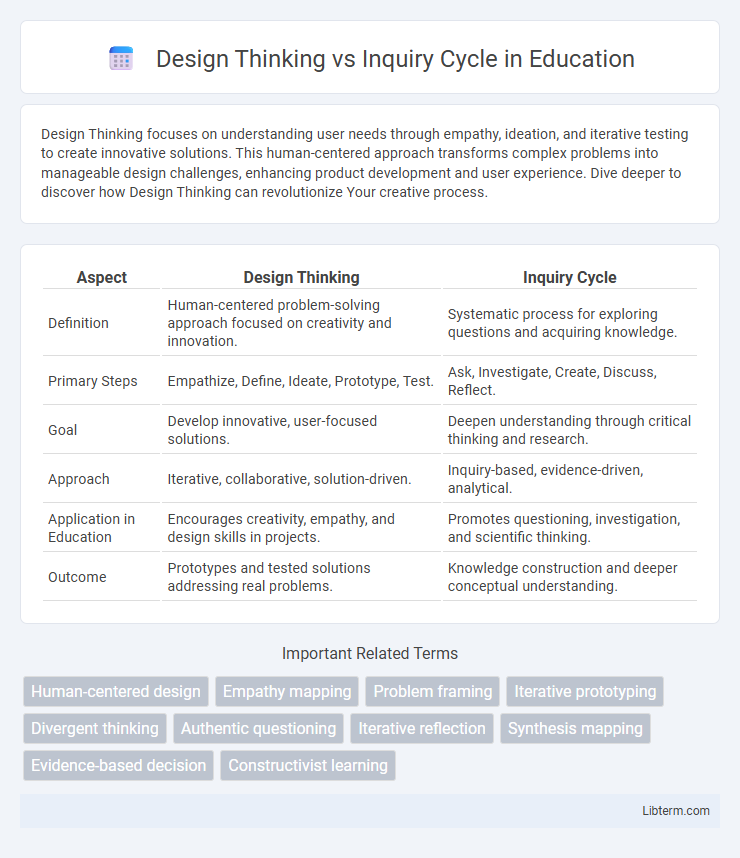Design Thinking focuses on understanding user needs through empathy, ideation, and iterative testing to create innovative solutions. This human-centered approach transforms complex problems into manageable design challenges, enhancing product development and user experience. Dive deeper to discover how Design Thinking can revolutionize Your creative process.
Table of Comparison
| Aspect | Design Thinking | Inquiry Cycle |
|---|---|---|
| Definition | Human-centered problem-solving approach focused on creativity and innovation. | Systematic process for exploring questions and acquiring knowledge. |
| Primary Steps | Empathize, Define, Ideate, Prototype, Test. | Ask, Investigate, Create, Discuss, Reflect. |
| Goal | Develop innovative, user-focused solutions. | Deepen understanding through critical thinking and research. |
| Approach | Iterative, collaborative, solution-driven. | Inquiry-based, evidence-driven, analytical. |
| Application in Education | Encourages creativity, empathy, and design skills in projects. | Promotes questioning, investigation, and scientific thinking. |
| Outcome | Prototypes and tested solutions addressing real problems. | Knowledge construction and deeper conceptual understanding. |
Introduction to Design Thinking and Inquiry Cycle
Design Thinking is a human-centered approach to innovation that emphasizes empathy, ideation, prototyping, and iterative testing to solve complex problems creatively. The Inquiry Cycle, rooted in educational theory, involves phases of questioning, investigating, reflecting, and applying knowledge to deepen understanding and foster critical thinking. Both frameworks promote active learning and problem-solving but differ in structure, with Design Thinking focusing on user experience and the Inquiry Cycle emphasizing knowledge construction.
Defining Design Thinking
Design Thinking is a human-centered approach to innovation that emphasizes empathy, ideation, and prototyping to solve complex problems creatively. It differs from the Inquiry Cycle by prioritizing iterative user feedback and co-creation throughout the process of defining and refining solutions. Key stages of Design Thinking include empathizing with users, defining problem statements, brainstorming ideas, prototyping, and testing for continuous improvement.
Understanding the Inquiry Cycle
The Inquiry Cycle centers on iterative questioning, investigation, and reflection to deepen comprehension and solve problems systematically. It emphasizes phases such as posing questions, gathering evidence, analyzing findings, and drawing conclusions, fostering critical thinking and continuous learning. This process contrasts with Design Thinking by prioritizing structured inquiry and knowledge-building over creative solution ideation.
Key Principles of Design Thinking
Design Thinking emphasizes human-centered problem solving through empathy, ideation, and iterative prototyping, fostering innovation by understanding user needs deeply. The methodology integrates divergent and convergent thinking phases, encouraging creative exploration followed by focused solution refinement. Key principles include collaboration across disciplines, embracing failure as a learning tool, and maintaining a solution-oriented mindset to address complex challenges effectively.
Core Stages of the Inquiry Cycle
The Core Stages of the Inquiry Cycle consist of questioning, investigating, creating, discussing, and reflecting, each driving deeper understanding through iterative exploration. Design Thinking parallels this process by emphasizing empathizing, defining, ideating, prototyping, and testing to solve user-centered problems. Both frameworks foster creativity and critical thinking, but the Inquiry Cycle specifically cultivates systematic knowledge building, making it essential in educational settings.
Comparison: Design Thinking vs Inquiry Cycle
Design Thinking emphasizes iterative problem-solving through empathy, ideation, prototyping, and testing to create user-centered solutions, while the Inquiry Cycle focuses on systematic questioning, investigation, and reflection to build understanding and knowledge. Design Thinking integrates creativity and practicality to address complex challenges in innovation-driven contexts, whereas the Inquiry Cycle prioritizes critical thinking and evidence-based reasoning in educational and research settings. Both models promote iterative processes, but Design Thinking leans toward product or service development, and the Inquiry Cycle targets cognitive growth and conceptual comprehension.
Applications in Education and Business
Design Thinking enhances education and business by fostering creativity and user-centered problem solving through iterative prototyping and empathy-driven research. The Inquiry Cycle emphasizes structured questioning and evidence-based investigation, promoting critical thinking and reflective learning essential in academic and organizational contexts. Integrating both methodologies cultivates adaptive strategies, enabling educators and businesses to innovate while grounding decisions in systematic inquiry.
Benefits of Each Approach
Design Thinking fosters innovation by emphasizing empathy, ideation, and iterative prototyping, enabling teams to create user-centered solutions that address real needs effectively. The Inquiry Cycle promotes reflective learning and critical thinking through systematic questioning, observation, and analysis, enhancing deeper understanding and informed decision-making. Both methodologies improve problem-solving skills, with Design Thinking driving creative outcomes and the Inquiry Cycle supporting structured knowledge acquisition.
Challenges and Limitations
Design Thinking often faces challenges such as time constraints, resource intensity, and difficulties in aligning diverse stakeholder perspectives during rapid prototyping and iteration phases. The Inquiry Cycle encounters limitations in its linear progression, which can restrict flexibility and adaptability when addressing complex or evolving problems. Both approaches require careful management to overcome potential biases and ensure comprehensive problem understanding while fostering creativity and critical analysis.
Choosing the Right Framework
Choosing the right framework between Design Thinking and the Inquiry Cycle depends on the project goals and problem complexity. Design Thinking excels in user-centered innovation by emphasizing empathy, ideation, and prototyping to solve ambiguous problems creatively. The Inquiry Cycle, grounded in scientific investigation, focuses on systematic questioning, data collection, and analysis, making it ideal for research-driven or evidence-based decision-making scenarios.
Design Thinking Infographic

 libterm.com
libterm.com